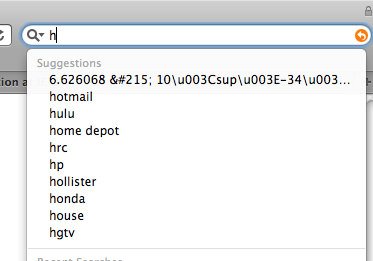A few days ago, my friend Melinda Shore, who knows I’m interested in internationalization, sent me a screenshot from the search bar of her Safari browser. It is a drop-down list of search suggestions provided by Google just after typing the letter h:

The top suggestion is a mess:
- What does it mean?
- Why is it a legitimate search suggestion for the letter h? (If it is.)
Regarding 1., the search suggestion in Firefox is nearly identical, but I cannot reproduce the effect in Google’s own browser Chrome or on the search page directly. In the Safari example, we’re dealing with an odd mix of regular character strings (6.626068, 10, sup, -34), numeric HTML (or XML) entities (×) and raw Unicode-escaped characters that you might find in Python, C or Java source code (\u003C, \u003E). Let’s decode the second and third type of components:
- \u003C and \u003E simply represent the Unicode code points U+003C and U+003E: the less-than and the greater-than signs < and >.
- × is U+00D7 MULTIPLICATION SIGN: ×
Putting it together, we get the already much more user-friendly form
6.626068 × 10<sup>-34
or, completing and resolving the HTML: 6.626068 × 10-34.
Once I realized this, my physics training kicked in and the answer to 2. became clearer – Planck’s constant, abbreviated as h, has the value of 6.62606889 × 10-34 J s (or m2 kg / s). This is not the result of injecting broken text into the search engine results, but a feature of Google’s calculator. Typing “G” into the browser’s search bar also yields similar semi-numeric character salad, while the results for “c“, “e” or “pi” are much more legible.
Still, the entire story raises questions about intent and execution. This is not really an internationalization issue because the form of those physical and mathematical constants is largely invariant by convention. Yet, the tools of internationalization — HTML entities, Unicode code point escapes — have leaked into scientific character display, too. Internationalization is a user interface (usability, user experience) issue [1].
On the execution side, Google got it wrong on several counts, and Apple and Mozilla share some of the blame. Browser search bar drop-down lists don’t allow for superscripts and aren’t sophisticated enough to strip markup, so they display ugly raw HTML. Choosing a numeric entity instead of the character × probably led to its display breaking. And < and > are even in ASCII, so they should display fine, but probably security concerns and their status as reserved HTML characters led to the odd choice of escaping method. All in all, at least one decoding step was not carried out.
More fundamentally, should Google suggest “6.626068 × 10-34 m2 kg / s” when you type a lowercase h? There was a time in my life when I used Planck’s constant daily, and I do use Google’s handy calculator via my browser’s search bar for quick arithmetic and unit conversions. But I think just spitting out the value with no label is going a little too far, and will for more than 99% of users be entirely unexpected: too different from the genuinely useful (for Americans) “hotmail”, “hulu” and “home depot”. Especially considering that for most letters of the alphabet, you could possibly find a scientific constant, function or theorem that starts with it.
Though maybe it is a ploy to spread more science among the people.
[1] It is also a design issue. The two aren’t mutually exclusive.

EDIT (2010-08-02): Commenters inside Facebook’s walled garden have remarked that if you actually take up the suggestion and search for it, you get to Planck’s constant. Currently this is partially right, but these things are constantly shifting: In my tests this morning, whether you use the Safari/Firefox search field or Google’s search page directly, you get a mix of results, the first of which are people wondering about the odd string on SEO forums. A little further down you do get collections of scientific constants, but you have to attentively read the result. Right now, this post is (after less than 12h) number 7 on the results page. None of the pages looks like what you get if you do a Google search for “h” (and hit return) — which is nice and helpful.
Another commenter remarks that for her, the suggestion is now prefaced with “Planck’s constant”, which is a vast improvement.